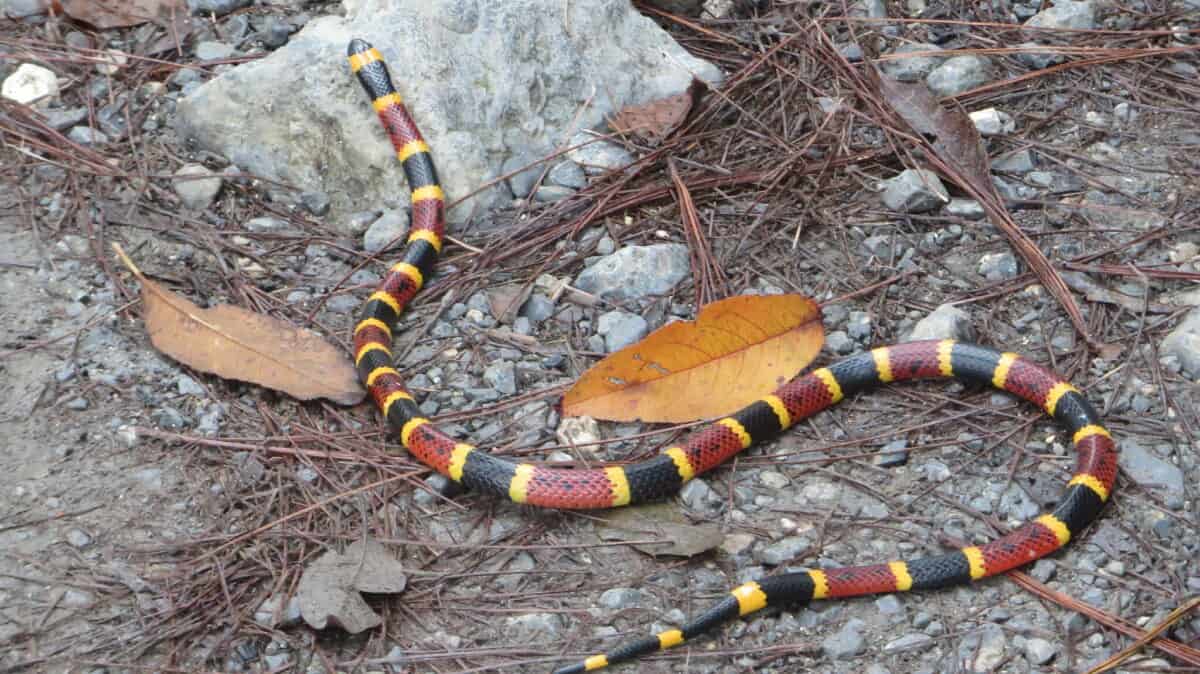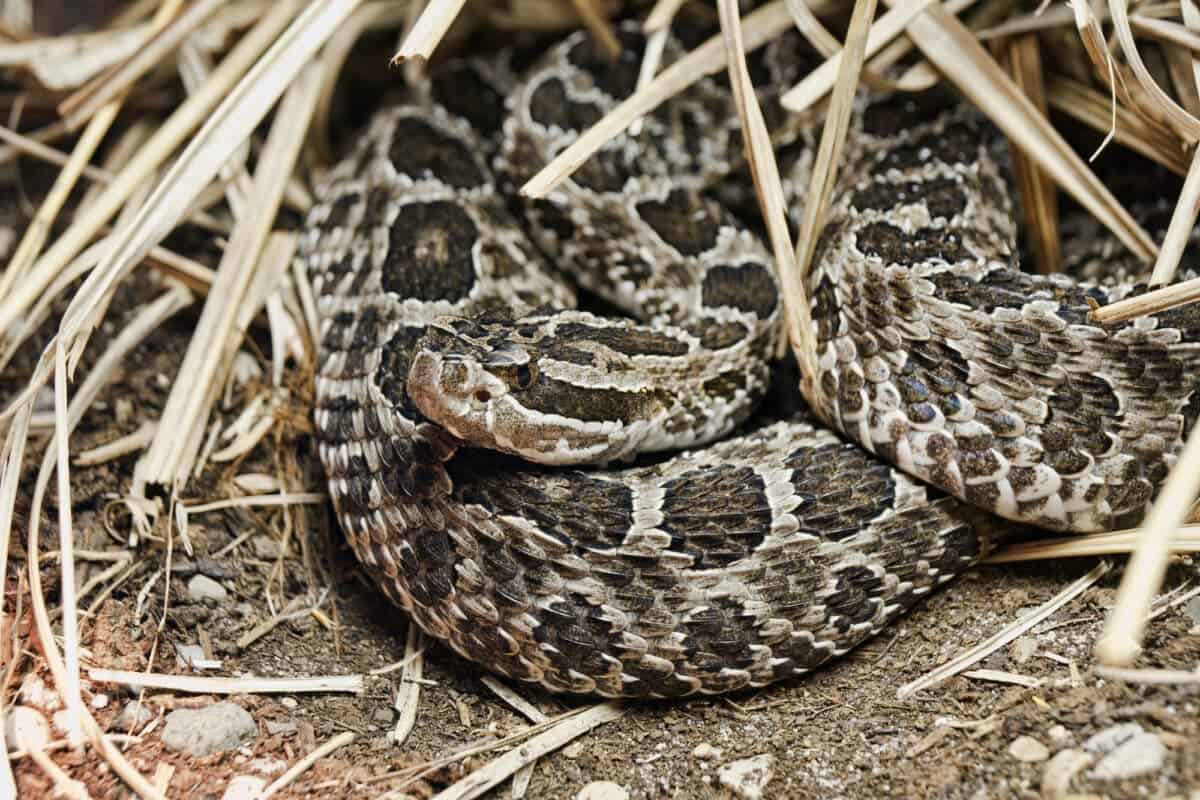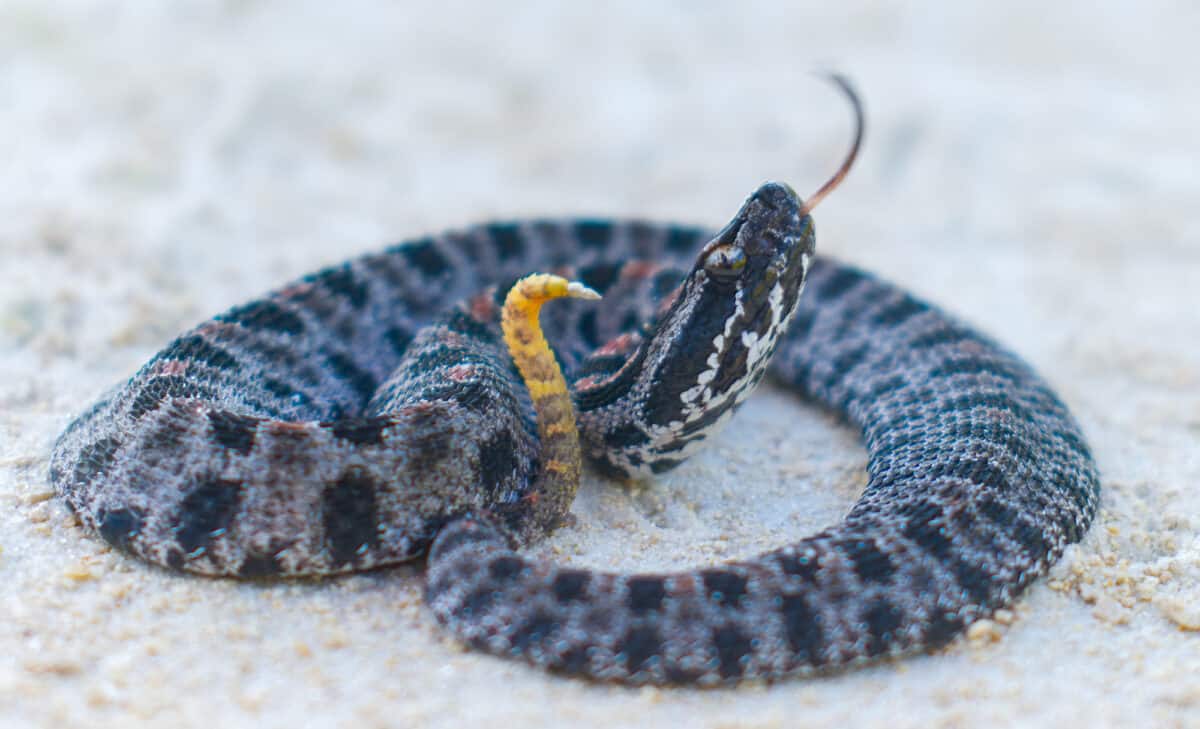Imagine strolling through a sunlit forest or hiking a rugged desert trail, only to realize you’re sharing the land with some of nature’s most fascinating—and dangerous—creatures. The United States is home to a surprising variety of venomous snakes, each with its own story, habitat, and warning signs. Some blend seamlessly into leaf litter, while others display bold patterns that seem to shout, “Beware!” Whether you’re an avid herpetologist or just someone who enjoys the great outdoors, knowing which snakes to watch for can be both thrilling and lifesaving. Let’s explore the top 14 venomous snakes slithering across the American landscape, uncovering their secrets and learning why these misunderstood reptiles are so captivating.
14 Eastern Diamondback Rattlesnake

The Eastern Diamondback Rattlesnake is a true legend of the Southeastern United States. With its bold diamond-shaped pattern and unmistakable rattle, this snake commands respect. Growing up to eight feet long, it’s the largest rattlesnake species in North America. Its venom is powerful, designed to quickly immobilize prey like rabbits and birds. Despite its fearsome reputation, the Eastern Diamondback is shy and prefers to avoid people, warning intruders with a loud rattle when threatened. Unfortunately, habitat loss and hunting have made encounters less common, but they’re still a symbol of wild southern landscapes. If you hear that telltale rattle, it’s nature’s way of saying, “Keep your distance!”
13 Western Diamondback Rattlesnake

The Western Diamondback Rattlesnake is famous across the arid regions of the Southwest, from Texas to California. Its chevron tail bands and diamond-like markings make it instantly recognizable. This snake is a survivor, thriving in deserts, rocky hills, and even grasslands. Its venom is potent, causing serious symptoms if bitten, which is why it’s wise to watch your step in its territory. Unlike some snakes that slither away at the first sign of trouble, the Western Diamondback will stand its ground, coiling and rattling loudly when it feels threatened. It’s an icon of the wild West, reminding adventurers to tread carefully and respect the creatures who call these dry lands home.
12 Timber Rattlesnake

Hidden among the forests and hills of the eastern United States, the Timber Rattlesnake is a master of camouflage. With earthy colors of brown, yellow, and black, it blends perfectly with fallen leaves and forest debris. This snake prefers quiet woodlands, often basking on sunny logs or rocky outcrops. Its venom is highly toxic, but bites are rare due to its reclusive nature. The Timber Rattlesnake is both feared and revered, a living symbol of the wild, untouched expanses of America’s forests. If you’re lucky enough to see one in the wild, it’s a thrilling reminder of the hidden wonders lurking just out of sight.
11 Mojave Rattlesnake

The Mojave Rattlesnake is notorious for its potent venom, which is among the most dangerous of any rattlesnake in the U.S. Found in deserts and scrublands of the Southwest, it’s a master of survival in harsh, dry conditions. Its greenish tint and diamond-shaped markings can make it hard to spot against sandy soil. The Mojave’s venom packs a double punch—affecting both nerves and blood—which is why medical attention is crucial if bitten. Despite its fearsome reputation, it prefers to avoid confrontation, often giving a warning rattle before striking. The Mojave Rattlesnake is a stark reminder that even the most beautiful landscapes can hide hidden dangers.
10 Prairie Rattlesnake

Roaming the grasslands from the Great Plains to the Rocky Mountains, the Prairie Rattlesnake is a true American original. Its color blends perfectly with prairie grasses, making it almost invisible until it moves. While its venom is dangerous, this snake primarily preys on rodents and birds, helping to keep the ecosystem balanced. The Prairie Rattlesnake is quick to defend itself, coiling and rattling if it feels threatened, but it would rather avoid people altogether. For ranchers and hikers, spotting one is a rare and memorable event, a reminder that the wild prairies are still alive with ancient predators.
9 Cottonmouth

The Cottonmouth, also known as the Water Moccasin, is famous for its menacing gape, revealing a bright white mouth as a warning. Found in the southeastern swamps, rivers, and lakes, it is a master swimmer, often seen gliding across the water’s surface. Its venom is highly potent, causing tissue damage if not treated quickly. The Cottonmouth’s dark body and thick build make it look intimidating, and its aggressive reputation is well-known among locals. Yet, like most snakes, it prefers to avoid people, striking only when cornered. Its presence is a chilling yet fascinating part of America’s wetlands.
8 Copperhead

Copperheads are the chameleons of the snake world, their coppery-brown bands blending perfectly with fallen leaves and forest floors. Found throughout the eastern and central United States, they are experts at remaining unseen. Their venom, while rarely fatal, causes intense pain and swelling, making them a significant hazard for those who venture off the beaten path. Copperheads are more likely to freeze than flee, relying on their camouflage to escape detection. This habit can lead to accidental encounters, especially for curious pets or barefoot hikers. Despite this, they play a crucial role in controlling rodent populations, showing how even the most feared creatures can be vital to nature’s balance.
7 Eastern Coral Snake

The Eastern Coral Snake is one of the most colorful and elusive venomous snakes in the U.S. Its bright red, yellow, and black bands are both beautiful and a bold warning—“Don’t touch!” Unlike most other American venomous snakes, the coral snake’s venom affects the nervous system. Though shy and rarely seen, a bite can be very serious, requiring urgent medical care. The Eastern Coral Snake is found mostly in the southeastern states, hiding under leaf litter or in sandy soils. Its shy nature means encounters are rare, but its striking appearance has inspired caution (and even nursery rhymes) for generations.
6 Texas Coral Snake

The Texas Coral Snake slithers through the woodlands, grasslands, and even suburban gardens of Texas and parts of the Southwest. Its vivid bands of red, yellow, and black make it easy to identify—if you know the rhyme about “red touching yellow.” The Texas Coral Snake is secretive, spending most of its life underground or hidden in leaf litter. Its venom is extremely potent, acting on the nervous system, but bites are rare due to its retiring habits. While it may be less aggressive than its rattlesnake cousins, its presence is always a reminder that beauty in nature often comes with a warning.
5 Eastern Massasauga

The Eastern Massasauga is a small but mighty rattlesnake, found in prairies, wetlands, and grassy fields of the Midwest and Northeast. Its subtle gray and brown coloring makes it easy to overlook, but its rattle is a clear signal to stay away. The Massasauga’s venom is less toxic than some larger rattlesnakes, but it still packs a punch, causing pain and swelling. This snake is shy and secretive, choosing to hide rather than confront. Unfortunately, loss of habitat has made it a threatened species in many areas, making sightings increasingly rare and special for wildlife enthusiasts.
4 Western Massasauga

The Western Massasauga is a close cousin to the Eastern variety, living in the grasslands and prairies of the central U.S. Slightly smaller and paler than other rattlesnakes, it relies on camouflage and caution to avoid danger. Its venom, while not usually deadly to adults, can cause significant pain and medical issues if left untreated. The Western Massasauga is more active at dusk and dawn, hunting for small prey like mice and frogs. Its presence is a testament to the resilience of prairie life, quietly maintaining balance in a world that often overlooks the small and hidden.
3 Pygmy Rattlesnake

The Pygmy Rattlesnake may be small, but it makes a big impression with its feisty attitude and rapid, buzzing rattle. Found in the southeastern U.S., it inhabits pine forests, marshes, and even sandy scrublands. Its tiny size and subtle coloring make it hard to spot, which can lead to surprise encounters. The Pygmy Rattlesnake’s venom is not usually life-threatening but can cause painful swelling and discomfort. It’s a perfect example of how even the smallest creatures can demand respect and caution. For those who appreciate the little things in nature, the Pygmy Rattlesnake is a hidden gem.
2 Arizona Black Rattlesnake

The Arizona Black Rattlesnake is a striking resident of the rocky canyons and pine forests of the Southwest. Its dark, almost black coloring helps it absorb heat and blend into the shadows. This rattlesnake is known for its ability to change color slightly, becoming darker or lighter with the temperature. Its venom is potent, but it rarely seeks out trouble, preferring to retreat when given the chance. The Arizona Black Rattlesnake is a symbol of the mysterious beauty of the desert mountains, a shadowy guardian of some of America’s most dramatic landscapes.
1 Red Diamond Rattlesnake

The Red Diamond Rattlesnake is a rare treasure, found only in southern California and northern Baja California. Its reddish-brown color and diamond-shaped markings make it one of the most beautiful rattlesnakes in the country. This snake prefers rocky hillsides and coastal scrub, basking in the sun or hiding among boulders. Its venom is less toxic than some other rattlesnakes, but a bite should always be taken seriously. The Red Diamond Rattlesnake is shy and slow to anger, often choosing flight over fight. Spotting one is a rare and memorable reward for those who explore California’s wild spaces.
Conclusion

The United States is home to an incredible variety of venomous snakes, each with its own unique story and place in the natural world. From the bold diamondbacks of the deserts to the secretive coral snakes of the Southeast, these reptiles are an essential part of America’s wild landscapes. They inspire fear, respect, and fascination in equal measure, reminding us that the wild is never far away. Whether you’re hiking, camping, or simply enjoying nature, being aware of these amazing creatures adds an extra layer of excitement and caution to every adventure. Did you expect so many different venomous snakes hiding across the country?
- 14 Venomous Snakes Found in the U.S. - August 12, 2025
- 12 Myths About Sloths Debunked by Science - August 12, 2025
- 13 Dog Breeds That Stay Puppy-Like Forever - August 12, 2025

